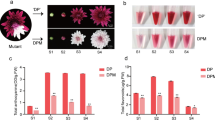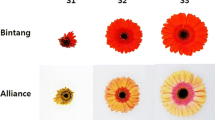Abstract
Ethanol and acetaldehyde both prevent the formation of ethylene bysenescing cut carnation flowers. This is due to the almost complete inhibitionof the activity of 1-aminocyclopropane-carboxylic acid oxidase. Thesetreatmentsalso reduce the 1-aminocyclopropane-1-carboxylic acid content of the tissue andresult in a loss of protein. The protein content of treated flowers wassignificantly lower than that of control flowers, due to a general rather thanspecific loss of protein. This affects the metabolism of the flowers,preventingenzyme mediated reactions as well as cell growth and development. One enzymethat remained active was alcohol dehydrogenase, allowing for a constantshuttling between ethanol and acetaldehyde.
Similar content being viewed by others
References
Hanson A.D. and Jacobsen J.V. 1984. Control of lactate dehydrogenase, lactate glycolysis and α-amylase by O2 deficit in barley aleurone layers. Plant Physiol. 75: 573–581.
Hanson A.D., Jacobsen J.V. and Zwar J.A. 1984. Regulated expression of three alcohol dehydrogenase genes in barley aleurone layers. Plant Physiol. 75: 566–572.
Heins R.D. 1980. Inhibition of ethylene synthesis and senescence in carnation by ethanol. J. Amer. Soc. Hort. Sci. 105: 141–144.
Heins R.D. and Blakely N. 1980. Influence of ethanol on ethylene biosynthesis and flower senescence of cut carnation. Sci. Hort. 13: 361–369.
Hills P.N., Van Staden J. and Viljoen C.D. 2001. Differences in polypeptide expression in thermoinhibited and germinating achenes of Tagetes minuta L. Plant Growth Regul. 34: 187–194.
Janes H.W. and Frenkel C. 1978. Promotion of softening process in pears by acetaldehyde, independent of ethylene action. J. Amer. Hort. Soc. 103: 397–400.
Kato-Noguchi H. 2000. Induction of alcohol dehydrogenase by plant hormones in alfalfa seedling. Plant Growth Regul. 30: 1–3.
Kneissel M.L. and Deikman J. 1996. The tomato E8 gene influences ethylene biosynthesis in fruit but not in flowers. Plant Physiol. 112: 537–547.
Kreuzwieser J., Harren F.J.M., Laarhoven L.J.J., Boamfa I., Te Lintel-Hekkert S., Scheerer U. et al. 2001. Acetaldehyde emission by the leaves of trees – correlation with physiological and environmental parameters. Physiol. Plant. 113: 41–49.
Laemmli U.K. 1970. Cleavage of structural proteins during the assembly of the head of bacteriophage T4. Nature 227: 680–685.
Lizada M.C.C. and Yang S.F. 1979. A simple and sensitive assay for 1-aminocyclopropane-1-carboxylic acid. Anal. Biochem. 100: 140–145.
Podd L.A. and Van Staden J. 1998. The role of ethanol and acetaldehyde in flower senescence and fruit ripening – a review. Plant Growth Regul. 26: 183–189.
Podd L.A. and Van Staden J. 1999a. Is acetaldehyde the causal agent in the retardation of carnation flower senescence by ethanol? J. Plant Physiol. 154: 351–354.
Podd L.A. and Van Staden J. 1999b. The use of acetaldehyde to control carnation flower longevity. Plant Growth Regul. 28: 175–178.
Podd L.A. and Van Staden J. 2002. The physiological response of cut carnation flowers to ethanol and acetaldehyde post-harvest treatments. I. Chlorophyll content and carbohydrate status Vol. Plant Growth Regul. 38: 99–105
Smith B.B.J. 1994. SDS polyacrylamide gel electrophoresis of proteins. In: Walker J.M. (ed.), Methods in molecular biology. Basic protein and peptide protocol. Humana Press, Totowa, pp. 23–34.
Wu M.-J., Zacarias L., Saltveit M.E. and Reid M.S. 1992. Alcohols and carnation senescence. HortScience 27: 136–138.
Author information
Authors and Affiliations
Corresponding author
Rights and permissions
About this article
Cite this article
Podd, L., Hills, P. & Van Staden, J. Physiological response and extension of vase life of cut carnation flowers treated with ethanol and acetaldehyde. II. Protein content and enzyme activity. Plant Growth Regulation 38, 107–117 (2002). https://doi.org/10.1023/A:1021219829005
Issue Date:
DOI: https://doi.org/10.1023/A:1021219829005




